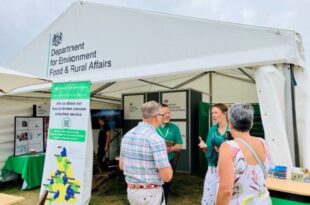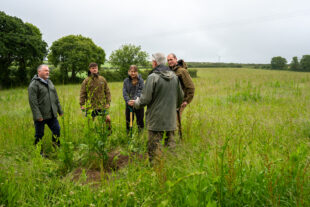https://defrafarming.blog.gov.uk/sustainable-farming-incentive-pilot-environmental-outcomes-and-benefits/
Sustainable Farming Incentive pilot: environmental outcomes and benefits
The guidance on this page is for SFI pilot participants only. Please visit GOV.UK for the official Sustainable Farming Incentive scheme guidance.
An overview of the 8 standards in the pilot, alongside their environmental outcomes and benefits.
The 8 standards will help farmers to create greener landscapes and improve biodiversity. They will promote cleaner air and water, and guard against environmental risks such as climate change and flooding.
1. Arable and horticultural land
There is good evidence that farmland biodiversity, including wild bird and pollinator populations, respond to the provision of habitat in the right places and at the right scale.
The habitat should provide year-round requirements including shelter and nesting cover, winter seed food and spring insect food for birds and nectar and pollen for insects.
Delivery for farm wildlife will be optimised if this standard is applied together with boundaries (hedgerows and water body buffering) and used to buffer and link areas of semi-natural habitat.
This standard also aims to improve the sustainability of arable management by reducing the impact of excessive nutrients and pesticides on the wider environment, such as water and air quality.
Environmental outcomes
The actions in this standard will:
- maintain and increase farm-scale habitat diversity and provide year-round resources for farm wildlife, including farmland birds
- increase resilience to climate change by providing refugia and increased connectivity
- integrate pest management, by providing habitats for beneficial predators
- increase pollination, by increasing habitats for wild pollinators
- improve soil condition and carbon storage by adding organic matter
- protect watercourses from sediment and pesticides in run-off
- improve landscape character by softening large arable blocks and increasing landscape diversity
- reduce the impact of nutrients on water and air quality and reduce greenhouse gas emissions
2. Arable and horticultural soils
Soil is one of our greatest natural assets, underpinning a wide range of benefits including clean and plentiful water, flood prevention, thriving plants and wildlife, climate change mitigation and food production.
Maintaining good soil structure and managing organic matter levels can improve water infiltration, moisture holding capacity, nutrient cycling, and carbon storage and enhance biodiversity.
Environmental outcomes
The actions in this standard will maintain or improve:
- soil structure and soil organic matter
- carbon storage
- water storage
- biodiversity
The actions will reduce levels of:
- sediment, nutrients and chemical pollution
- flooding
- greenhouse gas emissions
3. Farm woodland
Well managed woodland helps to improve biodiversity by providing habitat for many specialist and generalist species. Woodlands also provide a significant stock of carbon.
Environmental outcomes
The actions in this standard will:
- support the assessment of the woodland asset
- increase habitat for woodland and some farmland species
- increase habitat for pollinators
- provide connectivity between habitats through open space and ride management
- provide habitat for important invertebrates, fungi, and bats and increase carbon stocks through deadwood creation and maintenance
- increase woodland area through planting (optional)
4. Hedgerows
Hedgerows provide food, shelter and breeding cover for birds and insects. This standard increases the availability of blossom as a pollen and nectar source, and fruit and berries as a winter food source for birds. It should also improve the structure and longevity of hedgerows.
Hedgerows are an important historic landscape feature. They can link areas of woodland and other habitat to help species move around, increasing resilience to climate change.
Well developed hedgerows and hedgerow trees can help improve local air quality, reduce erosion and runoff, provide shade and shelter for livestock, and harbour beneficial insects which predate crop pests.
Over the next few years there will be a need to replace hedgerow trees lost to ash dieback and other tree diseases.
Environmental outcomes
Improved management of hedgerows will:
- maintain and strengthen the contribution of hedges to landscape character
- provide increased shelter and nesting cover, along with flower and berry food resources for a wide range of insects, birds and mammals
- maintain and improve habitat connectivity, increasing resilience to climate change
- contribute to improving local air quality
- reduce soil erosion
5. Improved grassland
There is scope to increase the biodiversity of improved grassland, by allowing areas to become more structurally diverse, with increased flowering and seed production.
Targeting this activity where it can link to existing features such as woodland, hedgerows and semi-natural areas will have additional benefits to wildlife, helping species move around.
More targeted and efficient use of nutrients will reduce their impact on the environment, including water and air quality. Reduced inputs, along with vegetation development, can improve soil function and carbon storage.
Environmental outcomes
The actions in this standard will:
- increase farm-scale habitat diversity and resources for wider countryside wildlife
- increase resilience to climate change by providing refugia and increased connectivity
- integrate pest management, by providing habitats for beneficial predators and invertebrate prey or weed seeds for declining farmland bird species
- increase pollination
- improve soil condition and carbon storage by reducing inputs and increasing organic matter
- improve water and air quality through increased nutrient management efficiency and reduced inputs
- improve landscape character by softening large grassland blocks and increasing landscape diversity
6. Improved grassland soils
Soil is one of our greatest natural assets, underpinning a wide range of benefits including clean and plentiful water, flood prevention, carbon storage, thriving plants and wildlife, climate change mitigation and food production.
Maintaining good soil function by feeding the life in the soil, limiting physical disruption, and providing the right chemical environment can maintain or improve soil structure, water infiltration, nutrient cycling, organic matter content, moisture holding capacity, carbon storage and enhance biodiversity.
Environmental outcomes
The actions in this standard will maintain or improve:
- soil structure and soil organic matter
- carbon storage
- water storage
- biodiversity
The actions will reduce levels of:
- sediment, nutrients and chemical pollution
- flooding
- greenhouse gas emissions
7. Low and no input grassland
Low and no input grassland has undergone a degree of modification through low level, but possibly regular, nutrient inputs, grazing, drainage and herbicide application.
Reseeding will not have taken place, or a number of years may have elapsed since any seeding was done and subsequent extensive management has allowed some native species to recolonise and spread.
Low and no input grassland can hold a range of wildflower and grass species, which are beneficial to pollinating insects as well as other groups. A degree of botanical diversity maintained by low intensity management is likely to sustain greater soil biodiversity and carbon sequestration than improved grassland.
The aim is to improve the sustainability of grassland management by reducing pressures on grassland systems from nutrient and herbicide inputs, and intensive livestock management.
Environmental outcomes
The actions in this standard will help to:
- maintain and improve wider countryside biodiversity, including key species and residual populations of plants more characteristic of unimproved grassland
- increase resilience to climate change by providing refugia, increased connectivity and opportunities for species colonisation and spread
- integrate pest management, by providing habitats for beneficial predators and invertebrate prey or weed seeds for declining farmland bird species
- increase pollination, by maintaining and improving habitats for wild pollinators
- maintain and improve soil condition and carbon storage by maintaining species diversity, reducing inputs and increasing organic matter
- improve water and air quality through low inputs
- increase natural flood management through increased vegetation structure and enhancing small wetlands
- maintain and enhance landscape character by retaining diverse grasslands and features
8. Water body buffering
Water bodies and the aquatic species they support remain under considerable pressure from sediment, nutrients, pathogens and other contaminants lost from agricultural land.
A highly effective place in the agricultural landscape to target management actions is at the boundary between farmed land and the water body. Water body buffers act as a physical barrier, reducing the risk of agricultural surface runoff reaching water bodies.
In cultivated fields, the strategic placement of in-field grass strips can help to reduce the connectivity of surface runoff pathways by protecting water bodies. Well designed buffers can have multiple benefits, including improved wildlife habitat, creation of wildlife corridors, and resilience to climate change.
Additional shrubs and trees in the riparian zone may also help to shade and cool rivers, increasing resilience to climate change.
Environmental outcomes
Water body buffering will:
- improve water quality by preventing pollutants, such as excessive nutrients and pesticides, from being transported in surface water run-off
- maintain and enhance water body habitats for aquatic species by reducing bankside erosion and transport of sediment and faecal indicator organisms (FIOs)
- maintain and enhance terrestrial habitat for insects, birds and small mammals
- maintain and improve habitat connectivity, forming links between other habitats and increasing resilience to climate change
- help to slow the flow of surface water runoff
9. Further information
For more information read the Sustainable Farming Incentive pilot: overview.
See all the Sustainable Farming Incentive pilot guidance.



